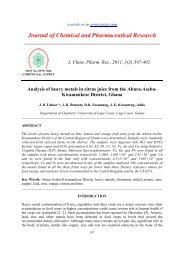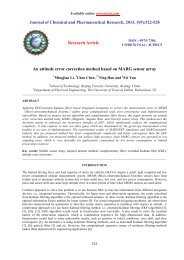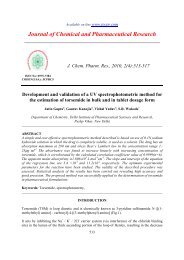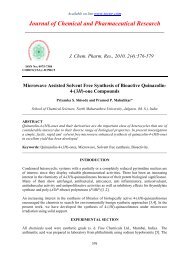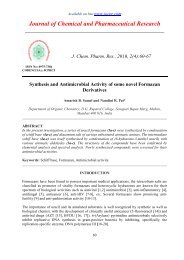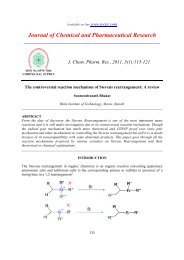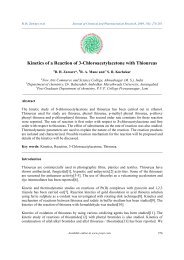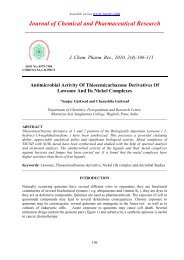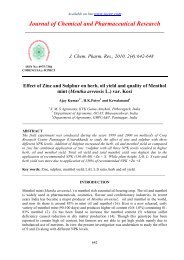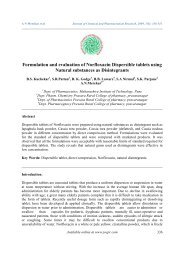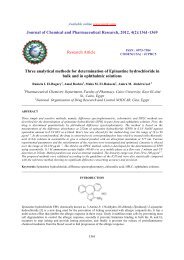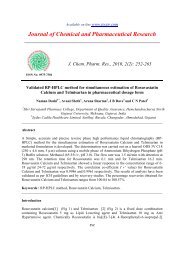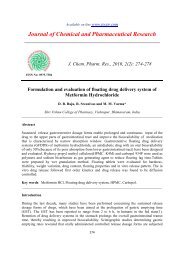EDTA-catalyzed fast and efficient eco-friendly synthesis of ...
EDTA-catalyzed fast and efficient eco-friendly synthesis of ...
EDTA-catalyzed fast and efficient eco-friendly synthesis of ...
You also want an ePaper? Increase the reach of your titles
YUMPU automatically turns print PDFs into web optimized ePapers that Google loves.
Available online www.jocpr.comJournal <strong>of</strong> Chemical <strong>and</strong> Pharmaceutical Research, 2013, 5(5):89-93Research ArticleISSN : 0975-7384CODEN(USA) : JCPRC5<strong>EDTA</strong>-<strong>catalyzed</strong> <strong>fast</strong> <strong>and</strong> <strong>efficient</strong> <strong>eco</strong>-<strong>friendly</strong> <strong>synthesis</strong> <strong>of</strong> dicoumarolderivatives in waterMaddela PrabhakarDepartment <strong>of</strong> Chemistry, Nagal<strong>and</strong> University, Lumami, Nagal<strong>and</strong>, India_____________________________________________________________________________________________ABSTRACT<strong>EDTA</strong>-Catalyzed a simple, <strong>fast</strong> <strong>and</strong> <strong>efficient</strong> <strong>eco</strong>-<strong>friendly</strong> green protocol for the <strong>synthesis</strong> <strong>of</strong> dicoumarol derivativesin excellent yields in water at room temperature. This <strong>EDTA</strong>-<strong>catalyzed</strong> aqueous reactions <strong>of</strong> 4-hydroxycoumarin <strong>and</strong>various aldehydes avoids the use <strong>of</strong> expansive, corrosive, toxic solvents <strong>and</strong> provides several advantages such asshort reaction time <strong>and</strong> scalable green <strong>synthesis</strong>.Key words: Dicoumarols, 4-Hydroxycoumarin, Aldehydes, <strong>EDTA</strong>-<strong>catalyzed</strong>, Aqueous media, Green Chemistry._____________________________________________________________________________________________INTRODUCTIONCoumarin compounds have gained the remarkable importance due to their widespread biological activities <strong>and</strong> alsoadditives to food, cosmetics, <strong>and</strong> optical brightening agents [1]. Coumarin ring system is one <strong>of</strong> the most importantsubstructure found in a large number <strong>of</strong> natural products <strong>and</strong> pharmacologically active compounds such asantibiotics [2] <strong>and</strong> antitumor drugs [3]. Coumarin derivatives have recently revealed new biological activities withinteresting potential in therapeutic application besides their traditional employment as anticoagulant <strong>and</strong> sustainingagents [4, 5]. Among the systems studied, the 3,3'-benzylidene bis(4-hydroxycoumarin-3-yl)toluene has been testedas a HIV integrase inhibitor <strong>and</strong> has shown significant activity [6, 7] <strong>and</strong> it was found that the minimum activepharmacophore consisted <strong>of</strong> a coumarin dimer containing an aryl substituent on the central linker methylene [6, 8].The addition <strong>of</strong> 4- <strong>and</strong> 7-hydroxy substituents in the coumarin rings improved the potency <strong>of</strong> the compounds.Due to their great importance, many synthetic strategies have been developed. Recently, there are several methodsreported in the literature for the <strong>synthesis</strong> <strong>of</strong> dicoumarols from 4-hydroxycoumarin <strong>and</strong> aldehydes in presence <strong>of</strong>different catalysts such as AcOH [9], MnCl 2 [10], ionic liquid [11], silica-supported preyssler nanoparticles [12],phosphotungstic acid [13], heteropolyacids [14], HCl [15], tetrabutylammonium bromide (TBAB) [16], silica gel[17], montmorillonite-KF [18], H 2 SO 4 [19], molecular iodine [20], piperidine [21] <strong>and</strong> phase transfer catalystTEBA [22]. However, these methods require prolonged reaction time <strong>and</strong> exotic reaction condition <strong>and</strong> some <strong>of</strong>these procedures require the use <strong>of</strong> toxic organic solvents, expensive catalysts <strong>and</strong> tedious workup. Thus, thedevelopment <strong>of</strong> a new method for the <strong>synthesis</strong> <strong>of</strong> dicoumarol derivatives would be highly desirable.In recent years, synthetic chemists are challenged to consider more environmentally <strong>friendly</strong> methods for generation<strong>of</strong> the desired target molecules. Among the 12 principles <strong>of</strong> green chemistry, the desire for to utilize ‘‘safersolvents’’ <strong>and</strong> to ‘‘design for energy efficiency’’ can be considered 2 key principles <strong>of</strong> relevance to syntheticchemists [23]. Because <strong>of</strong> the toxic <strong>and</strong> volatile nature <strong>of</strong> many organic solvents, water as a reaction medium wasconsidered a very promising <strong>and</strong> attractive substitute for volatile organic solvents <strong>and</strong> was widely used in the greenchemistry area since Breslow [24], who showed that hydrophobic effects could strongly enhance the rate <strong>of</strong> severalorganic reactions, rediscovered the use <strong>of</strong> water as a solvent in organic chemistry in 1980s. There has been growingr<strong>eco</strong>gnition that water is an attractive medium for many organic reactions, resulting in less expensive, less89
Maddela Prabhakar J. Chem. Pharm. Res., 2013, 5(5):89-93______________________________________________________________________________dangerous, <strong>and</strong> environmentally <strong>friendly</strong> reactions, such as Diels–Alder reactions [25], Claisen rearrangementreactions [26], Reformatsky reactions [27], <strong>and</strong> pinacol-coupling reactions [28].Presently, <strong>EDTA</strong> (ethylene diamine tetraacetic acid) have gained special attention as catalyst in organic <strong>synthesis</strong>because many advantages such as excellent solubility in water, uncomplicated h<strong>and</strong>ling, inexpensiveness <strong>and</strong> <strong>eco</strong><strong>friendly</strong>nature. To the best <strong>of</strong> our knowledge, there is no report <strong>of</strong> the application <strong>of</strong> <strong>EDTA</strong> catalyst for the<strong>synthesis</strong> <strong>of</strong> dicoumarol derivatives in aqueous media, <strong>and</strong> we hope that this will be a very useful, simple, <strong>fast</strong> <strong>and</strong>scalable green protocol for the preparation <strong>of</strong> dicoumarol derivatives in water.EXPERIMENTAL SECTIONAll reagents <strong>and</strong> solvents were <strong>of</strong> the highest commercial quality purchased from Aldrich & Merk <strong>and</strong> were usedwithout further purification. 1 H NMR spectra were r<strong>eco</strong>rded on a Bruker AC 400 ( 1 H NMR, 400 MHz) spectrometerwith tetramethylsilane (TMS) as an internal st<strong>and</strong>ard. Chemical shifts are reported in parts per million (ppm, δ).Infrared Spectra (IR) was r<strong>eco</strong>rded on JASCO IR-A-302 Spectrometer. CHN analysis was performed on a CarloErba Strumentazion-Mod-1106 Italy. Purities <strong>of</strong> assayed compounds are, in all cases, greater than 96%, asdetermined by reverse-phase HPLC analysis. Thin layer chromatography (TLC) was performed on pre-coated silicagel glass plates (Kieselgel 60, 254, E. Merck, Germany). Chromatograms were visualized by, UV at 254 <strong>and</strong> 365nm, followed by iodine vapors. Melting points were determined on a K<strong>of</strong>ler hot-stage apparatus <strong>and</strong> are uncorrected.SynthesisGeneral procedure for the <strong>synthesis</strong> <strong>of</strong> dicoumarol derivatives (3a-p): A mixture <strong>of</strong> 4-hydroxycoumarin (1) (2mmol) <strong>and</strong> aromatic/heteroaromatic aldehydes (2a-p) (1 mmol) in 15 mL <strong>of</strong> water was added <strong>EDTA</strong>-catalyst (10mol%) <strong>and</strong> stirred at room temperature for the appropriate time mentioned in Table 1. The completion <strong>of</strong> reactionwas monitored by Thin Layer Chromatography system. After completion <strong>of</strong> the reaction, the solid products wer<strong>eco</strong>llected by filtration methods <strong>and</strong> washed with hot water. Finally the products were recrystallized from ethanol togive the desired pure products (3a-p).Table 1. <strong>EDTA</strong>-<strong>catalyzed</strong> <strong>synthesis</strong> <strong>of</strong> dicoumarol derivatives (3a-p) in water aOH+ R CHOO O1 2a-p<strong>EDTA</strong>Water / rt, 20-40 min.OHOR HOO O O3a-pEntry R Product Time (min) Yield (%)1 C 6H 5 3a 30 962 4-CH 3OC 6H 4 3b 25 933 4-ClC 6H 4 3c 25 954 4-HOC 6H 4 3d 30 945 2-NO 2C 6H 4 3e 25 906 2-C 5H 4N 3f 30 857 2-C 4H 3O 3g 25 908 2,5-(OCH 3) 2C 6H 3 3h 20 989 4-N(CH 3) 2C 6H 4 3i 20 9610 H 3j 40 8511 CH 3 3k 35 8012 2-OHC 6H 4 3l 25 9213 3-ClC 6H 4 3m 20 9414 -CH=CH-C 6H 5 3n 30 9315 1-Naphthyl 3o 25 9016 2,4,5-(OCH 3) 3C 6H 2 3p 20 98a Reaction conditions: <strong>EDTA</strong> (10 mol %), 4-hydroxycoumarin (2.0 mmol); Benzaldehyde (1.0 mmol); 15 mL water at RT.All synthesized compounds were characterized with 1 H-NMR <strong>and</strong> mass spectrometry. Also the melting pointsr<strong>eco</strong>rded were compared with the corresponding literature melting points <strong>and</strong> found to be matching.RESULTS AND DISCUSSIONIn this paper, we wish to report a <strong>EDTA</strong>-<strong>catalyzed</strong> green approach for the <strong>synthesis</strong> <strong>of</strong> dicoumarol derivatives inwater at room temperature (Scheme 1). In our initial study, 4-hydroxycoumarin was reacted with benzaldehyde inthe presence <strong>of</strong> NH 4 OAc in water solution under refluxing temperature for 1 h <strong>and</strong> the expected product was90
Maddela Prabhakar J. Chem. Pharm. Res., 2013, 5(5):89-93______________________________________________________________________________obtained in 85% yield (Table 2, entry 6). The use <strong>of</strong> other catalysts (Table 2, entries 1-5) does not improved theyields even after several hours in water under reflux conditions. However, excellent yield was achieved when thereaction was carried out in presence <strong>of</strong> <strong>EDTA</strong> in water at room temperature <strong>and</strong> the reaction was completed within30 min affording the desired product in 96% yield (Table 2, entry 7).OH+ R CHOO O1 2a-p<strong>EDTA</strong>Water / rt, 20-40 min.OHOR HOO O O3a-pScheme 1. <strong>EDTA</strong> Catalyzed Synthesis <strong>of</strong> Dicoumarol Derivatives in Water.Table 2. Evaluation <strong>of</strong> catalytic activity <strong>of</strong> different catalysts for the <strong>synthesis</strong> <strong>of</strong> dicoumarol (3a) in waterEntry Catalyst Mol (%) Time Yield (%)1 AcOH 10a 5 h 802 I 2 10a 4 h 753 pTSA 10a 10 h 654 NH 4Cl 10a 10 h 605 LiBr 10a 3 h 706 NH 4OAc 10a 1 h 857 <strong>EDTA</strong> 10b 30 min 96a Reaction conditions: 4-hydroxycoumarin (2.0 mmol); Benzaldehyde (1.0 mmol); Catalyst (10 mol%); in water (15 mL) under reflux conditions.b Reaction conditions: 4-hydroxycoumarin (2.0 mmol); Benzaldehyde (1.0 mmol); Catalyst (10 mol%); in water (15 mL) at RT.In order to optimize the <strong>EDTA</strong>-<strong>catalyzed</strong> reactions, we have evaluate the reaction <strong>of</strong> 4-hydroxycoumarin <strong>and</strong>benzaldehyde to afford 3a in various other organic solvents such as CH 3 OH, dichloromethane <strong>and</strong> CH 3 CN at roomtemperature for 24 h, <strong>and</strong> percentage <strong>of</strong> yields are very poor with compare to the water-mediated green protocol(Table 2, entry 7).This observations encouraged us to exp<strong>and</strong> the scope <strong>and</strong> generality <strong>of</strong> this st<strong>and</strong>ardized <strong>EDTA</strong>-<strong>catalyzed</strong> reactionmethodology in Water, a range <strong>of</strong> dicoumarol derivatives 3a-p were synthesized starting from 4-hydroxycoumarin<strong>and</strong> various aldehydes (Scheme 1 <strong>and</strong> Table 1, entries 1-16) in presence <strong>of</strong> <strong>EDTA</strong> in water at room temperature. Themethod was found to be equally effective for the condensation <strong>of</strong> 4-hydroxycoumarin with aromatic aldehydesbearing electron-withdrawing (3c, 3e) as well as electron-donating (3b, 3p) substituents <strong>and</strong> heteroaromaticaldehydes (3f <strong>and</strong> 3g) are summarized in Table 1. The yields obtained for dicoumarol derivatives (3a-p) were goodto excellent <strong>and</strong> were in the range <strong>of</strong> the 80-98% (Table 1, entries 1-16).Spectral characterization dataCompound 3a: White solid (Yield: 96%); Mp: 229–232 o C; 1 H-NMR (CDCl 3 ) δ: 6.23 (s, 1H, CH), 7.23–8.11 (m,13H, Ar-H), 11.31 (s, 1H, OH), 11.54 (s, 1H, OH); 13 C-NMR (CDCl 3 ) δ: 36.23, 105.69, 116.64, 124.40, 124.87,126.48, 126.89, 128.64, 132.83, 135.23, 152.54; IR (KBr) ν: 3423, 3034, 1675, 1612, 1562, 1494, 1443, 1349, 758cm –1 ; Anal. calcd. for C 25 H 16 O 6 : C, 72.81; H, 3.91. Found: C, 72.79; H, 3.86.Compound 3b: White solid (Yield: 93%); Mp: 246–249 o C; 1 H-NMR (CDCl 3 ) δ: 3.83 (s, 3H, CH 3 O), 6.05 (s, 1H,CH), 6.85–8.05 (m, 12H, Ar-H), 11.32 (s, 1H, OH), 11.53 (s, 1H, OH); 13 C-NMR (CDCl 3 ) δ: 35.53, 54.26, 114.06,116.63, 124.42, 124.84, 126.93, 127.63, 132.78, 158.43, 135.23, 152.54; IR (KBr) ν: 3453, 3072, 1673, 1614, 1562,1505, 1454, 1353, 1306, 1254, 765 cm –1 ; Anal. calcd. for C 26 H 18 O 7 : C, 70.58; H, 4.10. Found: C, 70.64; H, 4.13.Compound 3c: White solid (Yield: 95%); Mp: 257–260 o C; 1 H-NMR (CDCl 3 ) δ: 6.03 (s, 1H, CH), 7.15–8.11 (m,12H, Ar-H), 11.32 (s, 1H, OH), 11.56 (s, 1H, OH); 13 C-NMR (CDCl 3 ) δ: 35.73, 103.73, 105.29, 116.63, 124.42,124.93, 127.86, 128.83, 132.75, 133.93, 152.54, 164.63, 166.84, 169.23; IR (KBr) ν: 3425, 3068, 1675, 1613, 1560,1494, 1489, 1443, 1349, 1274, 1213, 763 cm –1 ; Anal. calcd. for C 26 H 15 ClO 6 : C, 67.20; H, 3.38. Found: C, 67.28; H,3.42.Compound 3d: White solid (Yield: 94%); Mp: 220–223 o C; 1 H-NMR (CDCl 3 ) δ: 6.22 (s, 1H, CH), 7.03–8.16 (m,12H, Ar-H), 9.82 (s, 1H, OH), 11.32 (s, 1H, OH), 11.53 (s, 1H, OH); 13 C-NMR (CDCl 3 ) δ: 36.26, 106.12, 116.63,124.45, 125.07, 126.48, 127.12, 128.64, 132.85, 135.26, 152.53; IR (KBr) ν: 3340, 3035, 1670, 1607, 1562, 1493,1443, 1349, 763 cm –1 ; Anal. calcd. for C 25 H 16 O 7 : C, 70.09; H, 3.76. Found: C, 70.14; H, 3.79.91
Maddela Prabhakar J. Chem. Pharm. Res., 2013, 5(5):89-93______________________________________________________________________________Compound 3e: Yellow solid (Yield: 90%); Mp: 234–236 o C; 1 H-NMR (CDCl 3 ) δ: 6.53 (s, 1H, CH), 7.26–8.34 (m,12H, Ar-H); 13 C-NMR (CDCl 3 ) δ: 35.56, 114.06, 116.67, 123.38, 124.84, 126.86, 127.63, 133.18, 158.46, 135.22,153.14; IR (KBr) ν: 3035, 1660, 1614, 1530, 1505, 1348, 1306, 765 cm –1 ; Anal. calcd. for C 25 H 15 NO 8 : C, 65.65; H,3.31; N, 3.06. Found: C, 65.72; H, 3.34; N, 2.98.Compound 3f: brown solid (Yield: 85%); Mp: 323–326 o C; 1 H-NMR (DMSO-d 6 ) δ: 6.33 (s, 1H, CH), 6.60 (d, J=2.1Hz, 2H), 6.67 (dd, J=8.6, J=2.2 Hz, 2H), 7.59 (d, J=8.7 Hz, 2H), 7.88 (dd, J=8.1, J=5.7 Hz, 1H), 8.25 (d, J=8.0 Hz,1H), 8.53 (s, 1H), 8.66 (d, J=5.6 Hz, 1H), 10.20 (s, 2H, OH); IR (KBr) ν: 3450, 3179, 1685, 1613, 1560, 1404, 760cm –1 ; Anal. calcd. for C 24 H 15 NO 6 : C, 69.73; H, 3.66; N, 3.39. Found: C, 69.76; H, 3.73; N, 3.42.Compound 3g: Black solid (Yield: 90%); Mp: 200–203 o C; 1 H-NMR (CDCl 3 ) δ: 6.08 (s, 1H, CH), 6.34–6.57 (m,3H, Furyl-H), 7.32–8.30 (m, 8H, Ar-H), 11.37 (s, 1H, OH), 11.54 (s, 1H, OH); 13 C-NMR (CDCl 3 ) δ: 36.25, 104.69,115.63, 124.83, 126.89, 128.62, 132.85, 135.00, 152.53; IR (KBr) ν: 3034, 1658, 1602, 1562, 1494, 1349, 768 cm –1 ;Anal. calcd. for C 23 H 14 O 7 : C, 68.66; H, 3.51. Found: C, 68.63; H, 3.48.Compound 3h: White solid (Yield: 98%); Mp: 264–267 o C; 1 H-NMR (CDCl 3 ) δ: 3.69 (s, 3H, OCH 3 ), 3.86 (s, 3H,OCH 3 ), 6.13 (s, 1H, CH), 6.74–8.12 (m, 11H, Ar-H), 11.34 (s, 1H, OH), 11.59 (s, 1H, OH); 13 C-NMR (CDCl 3 ) δ:35.73, 55.84, 56. 03, 110.49, 111.34, 116.64, 118.93, 124.40, 124.86, 127.53, 132.89, 148.10, 149.23, 152.43; IR(KBr) ν: 3436, 3075, 1673, 1612, 1562, 1513, 1450, 1353, 1307, 1254, 765 cm –1 ; Anal. calcd. for C 27 H 20 O 8 : C,68.43; H, 4.25. Found: C, 68.39; H, 4.23.Compound 3i: White solid (Yield: 96%); Mp: 213–216 o C; 1 H-NMR (DMSO-d 6 ) δ: 3.23 (s, 6H, 2CH 3 ), 6.34 (s, 1H,CH), 7.23–7.86 (m, 12H, Ar-H); 13 C-NMR (DMSO-d 6 ) δ: 36.43, 103.69, 116.14, 120.10, 123.46, 124.57, 128.62,131.64, 141.23, 153.10, 164.93, 167.94; IR (KBr) ν: 3424, 3083, 1665, 1610, 1562, 1523, 1446, 1350, 1305, 763cm –1 ; Anal. calcd. for C 27 H 21 NO 6 : C, 71.20; H, 4.65; N, 3.08. Found: C, 71.16; H, 4.64; N, 3.03.Compound 3j: white solid (Yield: 85%); Mp: 272–275 o C; 1 H-NMR (DMSO-d 6 ) δ: 3.94 (s, 2H, CH 2 ), 7.20 (td, 2H,J=7.8, J=2.1 Hz, H-6/6'), 7.33 (d, 2H, J=7.8 Hz, H-8/8'), 7.56 (td, 2H, J=7.8, J=2.0 Hz, H-7/7'), 7.95 (d, 2H, J=7.8Hz, H-5/5'); IR (KBr) ν: 3647, 3064, 1650, 1596, 1565, 1453, 1344, 765 cm –1 ; Anal. calcd. for C 19 H 12 O 6 : C, 67.86;H, 3.60. Found: C, 67.89; H, 3.64.Compound 3k: white solid (Yield: 80%); Mp: 173–176 o C; 1 H-NMR (DMSO-d 6 ) δ: 1.43 (d, 3H, J=5.6 Hz, CH 3 ),4.32 (s, 1H, CH-11), 7.25 (td, 2H, J=7.8, J=2.5 Hz, H-6/6'), 7.33 (d, 2H, J=7.8 Hz, H-8/8'), 7.41 (td, 2H, J=2.3 Hz,H-7/7'), 7.72 (d, 2H, J=7.8 Hz, H-5/5'); IR (KBr) ν: 3643, 3059, 1654, 1586, 1563, 1443, 758 cm –1 ; Anal. calcd. forC 20 H 14 O 6 : C, 68.57; H, 4.03. Found: C, 68.53; H, 3.96.Compound 3l: Yellow solid (Yield: 92%); Mp: 252–254 o C; 1 H-NMR (CDCl 3 ) δ: 6.43 (s, 1H, CH), 7.14–8.13 (m,12H, Ar-H), 8.60 (s, 1H, OH), 11.28 (s, 1H, OH), 11.56 (s, 1H, OH); 13 C-NMR (CDCl 3 ) δ: 36.13, 105.73, 116.64,124.47, 124.85, 126.46, 127.14, 128.64, 133.82, 135.24, 152.57; IR (KBr) ν: 3423, 3035, 1675, 1613, 1564, 1496,1443, 1347, 765 cm –1 ; Anal. calcd. for C 25 H 16 O 7 : C, 70.09; H, 3.76. Found: C, 70.13; H, 3.79.Compound 3m: white solid (Yield: 94%); Mp: 213–216 o C; 1 H-NMR (CDCl 3 ) δ: 6.06 (s, 1H, CH), 7.16–8.14 (m,12H, Ar-H), 11.32 (s, 1H, OH), 11.58 (s, 1H, OH); 13 C-NMR (CDCl 3 ) δ: 35.75, 103.76, 105.30, 117.23, 124.42,124.93, 128.06, 128.83, 132.72, 131.25, 152.53, 164.68, 167.03, 169.24; IR (KBr) ν: 3423, 3065, 1670, 1614, 1565,1493, 1443, 1350, 1275, 765 cm –1 ; Anal. calcd. for C 25 H 15 ClO 6 : C, 67.20; H, 3.38. Found: C, 67.26; H, 3.43.Compound 3n: Pale yellow solid (Yield: 93%); Mp: 227–230 o C; 1 H-NMR (CDCl 3 ) δ: 6.53 (s, 1H, CH), 6.61 (d, 1H,CH), 6.72 (d, 1H, CH), 7.13–8.14 (m, 12H, Ar-H), 11.31 (s, 1H, OH), 11.54 (s, 1H, OH); 13 C-NMR (CDCl 3 ) δ:36.25, 96. 73, 97.52, 106.68, 116.65, 124.40, 124.89, 126.58, 127.84, 128.64, 132.83, 135.26, 152.53; IR (KBr) ν:3323, 3034, 3026, 1723, 1672, 1614, 1562, 1443, 1349, 766 cm –1 ; Anal. calcd. for C 27 H 18 O 6 : C, 73.97; H, 4.14.Found: C, 73.88; H, 4.09.Compound 3o: Yellow solid (Yield: 90%); Mp: 245–248 o C; 1 H-NMR (DMSO-d 6 ) δ: 6.74 (s, 1H, CH), 7.24–7.32(m, 5H, Ar-H), 7.35–7.41 (m, 4H, Ar-H), 7.48–7.56 (m, 3H, Ar-H), 7.72 (d, 1H, J=8.8 Hz), 7.83 (d, 2H, J=8.8 Hz,CH); 13 C-NMR (DMSO-d 6 ) δ: 36.23, 106.68, 117.14, 124.40, 124.87, 126.48, 126.89, 127.32, 128.64, 130.16,132.14, 132.83, 135.23, 152.54; IR (KBr) ν: 3424, 3060, 2973, 1656, 1603, 1562, 1443, 1349, 764 cm –1 ; Anal.calcd. for C 29 H 18 O 6 : C, 75.32; H, 3.92. Found: C, 75.26; H, 3.89.Compound 3p: White solid (Yield: 98%); Mp: 270–273 o C; 1 H-NMR (CDCl 3 ) δ: 3.68 (s, 3H, OCH 3 ), 3.83 (s, 3H,OCH 3 ), 3. 92 (s, 3H, CH 3 ), 6.14 (s, 1H, CH), 6.73–8.14 (m, 10H, Ar-H), 11.33 (s, 1H, OH), 11.56 (s, 1H, OH); 13 C-92
Maddela Prabhakar J. Chem. Pharm. Res., 2013, 5(5):89-93______________________________________________________________________________NMR (CDCl 3 ) δ: 35.73, 55.84, 56. 03, 56.73, 110.48, 112.36, 116.67, 118.94, 124.43, 125.26, 127.59, 132.86,147.93, 149.24, 152.46; IR (KBr) ν: 3435, 3074, 1670, 1613, 1564, 1513, 1452, 1353, 1313, 1256, 765 cm –1 ; Anal.calcd. for C 28 H 22 O 9 : C, 66.93; H, 4.41. Found: C, 66.98; H, 4.43.CONCLUSIONIn conclusion, we have developed <strong>EDTA</strong>-<strong>catalyzed</strong> simple, <strong>fast</strong> <strong>and</strong> <strong>efficient</strong> <strong>eco</strong>-<strong>friendly</strong> synthetic green protocolin water at room temperature <strong>and</strong> the present methodology was superior to the literature methods in terms <strong>of</strong>scalable green <strong>synthesis</strong> in water.AcknowledgmentsMP thanks the Vice-Chancellor, Nagal<strong>and</strong> University, Head <strong>of</strong> the Chemistry Department <strong>and</strong> all the Facultymembers <strong>and</strong> staff for their constant support <strong>and</strong> providing chemicals. MP thank the University <strong>of</strong> Hyderabad forproviding scientific facilities for this work.REFERENCES[1] (a) R Okenne; RD Thomes, Coumarins: Biology application <strong>and</strong> modes <strong>of</strong> action; Wiley & Sons: Chichester.,1997. (b) M Zahradnik, The production <strong>and</strong> application <strong>of</strong> fluorescent brightening agents; Wiley & Sons:Chichester., 1992.[2] JW Hinman; H Hoeksema; EL Caron; WG Jackson, J. Am. Chem. Soc., 1956, 78, 1072-1074.[3] YL Chen; T. C. Wang, C. C. Tzeng, N. C. Chang, Helv. Chim. Acta., 1999, 82, 191-197.[4] A Stahmann; M Ikawa; KP Link, US Patent., 1947, 2427578; Chem. Abstr., 1948, 42, P603h.[5] RDH Murray; J Mendez; SA Brown, Natural coumarins; Wiley: Chichester, 1982.[6] H Zhao; N Neamati; H Hong; A Mazumder; S Wang; S Sunder; GWA Milne; Y Pommier; TR Burke,Coumarin-based inhibitors <strong>of</strong> HIV integrase. J. Med. Chem., 1997, 40, 242–249.[7] SU Chang-Xiao; M Jean-Francois; C Chih-Chia; T Hou-Jen; H Ling-Yih, Chem. Pharm. Bull., 2006, 54, 682–686.[8] GK Maria; E Marian, J. Med. Pharm. Chem., 1961, 3, 583–595.[9] (a) Hamdi; Naceur et al., European Journal <strong>of</strong> Medicinal Chemistry., 2008, 43(11), 2541-2548. (b) Ilia IManolov; Danchev; D Nicolay, Archiv der Pharmazie (Weinheim, Germany)., 2003, 336(2), 83-94. (c) Ilia IManolov, Tetrahedron Letters., 1998, 39(19), 3041-3042.[10] Sangshetti; N Jaiprakash et al., Green Chemistry Letters <strong>and</strong> Reviews., 2009, 2(4), 233-235.[11] Khurana; M Jitender; Kumar; Sanjay, Monatshefte fuer Chemie., 2010, 141(5), 561-564.[12] Heravi; M Majid et al., Synthetic Communications., 2010, 40(4), 498-503.[13] Singh; Prashant et al., Catalysis Letters., 2010, 134(3-4), 303-308.[14] Heravi; M Majid et al., Catalysis Communications., 2009, 10(13), 1643-1646.[15] Matache; Mihaela et al., Tetrahedron., 2009, 65(31), 5949 -5957.[16] Khurana; M Jitender; Kumar; Sanjay, Tetrahedron Letters., 2009, 50(28), 4125-4127.[17] Qadir; Saima et al., Synthetic Communications., 2008, 38(20), 3490-3499.[18] Wu, Nan et al., Journal <strong>of</strong> Chemical Research, 2007, 10, 561-562.[19] Pansuriya; B Pramod; Patel; N Mohan, Applied Organometallic Chemistry., 2007, 21(9), 719-727.[20] Kidwai; Mazaahir et al., Journal <strong>of</strong> Molecular Catalysis A: Chemical., 2007, 268(1-2), 76-81.[21] KM Khan; S Iqbal; M Arif Lodhi; G Murtaza Maharvi; Zia-Ullah; M Iqbal; Choudhary; Atta-ur-Rahmana; SPerveen, Bioorganic & Medicinal Chemistry., 2004, 12, 1963–1968.[22] Wang; Jing et al., Youji Huaxue., 2005, 25(8), 926-929.[23] D Dallinger; CO Kappe, Chem. Rev., 2007, 107, 2563–2591.[24] (a) R Breslow; DC Rideout, J. Am. Chem. Soc., 1980, 102, 7816–7817. (b) R Breslow, Acc. Chem. Res., 1991,24, 159–164.[25] (a) R Breslow; U Maitra; DC Rideout, Tetrahedron Lett., 1983, 24, 1901–1904. (b) R Breslow; U Maitra,Tetrahedron Lett., 1984, 25, 1239–1240.[26] (a) AA Ponaras, A new variant <strong>of</strong> the Claisen rearrangement capable <strong>of</strong> creating the bond between twoquaternary centers. J. Org. Chem., 1983, 48, 3866–3868. (b) RM Coates; BD Rogers; SJ Hobbs; DR Peck; DPCurran, J. Am. Chem. Soc., 1987, 109, 1160–1170.[27] (a) H. Mattes, C Benezra, Tetrahedron Lett., 1985, 26, 5697–5698. (b) JY Zhou; GD Lu; SH Wu, Synth.Commun., 1992, 22, 481–487.[28]. P. Delair, J. L. Luche, J. Chem. Soc., Chem. Commun. 1989, 7, 398.93



